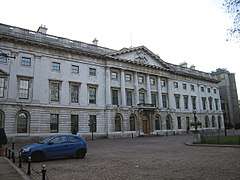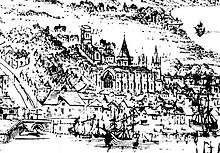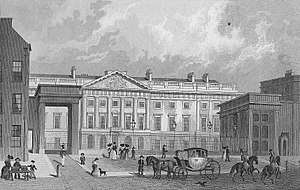Royal Mint Court
Royal Mint Court is a property on Little Tower Hill[1] in Tower Hill and is in London's East End, close to the City of London financial district.
| Royal Mint Court | |
|---|---|
 Johnson Smirke Building | |

| |
| General information | |
| Town or city | London |
| Country | England |
The site was the home of the Royal Mint from 1809 until 1967 and was earlier the site of a Cistercian abbey, built in 1348 and known in its time as Eastminster. Eastminster's foundations are relatively well preserved and visible in the partially open basement of the site.[2]
After the Dissolution of the Monasteries, the 5.5 acre (2 hectare) property[3] was used as a victualling yard for the Royal Navy, then as a tobacco warehouse, before becoming a mint in 1809. After the mint relocated, the site was redeveloped with a new office and residential block[4] added to the complex alongside the two remaining Grade II listed mint buildings.
In 2017, Royal Mint Court was again set to be redeveloped with plans for a new office, shopping and leisure complex. Planning permission was granted in July 2016.[5] However in May 2018 the site was sold to the People's Republic of China to be used for their new London embassy.[6]
History

During the Black Death in 1349 the site became a plague cemetery known as the Churchyard of the Holy Trinity, and three mass burial trenches and 14 grave rows were dug alongside a small chapel. During excavation of the site between 1986–1988 the remains of 762 bodies were recovered, as well as a number of belt buckles and two hoards of coins.[7] On 20 March 1350 Edward III granted the site to the Cistercian order for the building of a new chapel named the Royal Free Chapel of St Mary Graces on Tower Hill, which eventually became the Abbey of St. Mary de Graces; the monastery was known as Eastminster, or sometimes New Abbey.[8] Built to house just ten monks and an abbot, the abbey was the last Cistercian foundation in England to be built before the Dissolution of the Monasteries. In 1538 St Mary Graces was surrendered to the Crown and sold to Sir Arthur Darcy, who demolished part of the monastery buildings and lived there until his death in 1560. The site was then sold back to the Crown; it was a victualling yard for the Royal Navy until 1739, when the navy moved to new premises in Deptford.
The Royal Mint

The Royal Mint, previously housed in the Tower of London, moved to the site between 1806 and 1811, and the Mint's new buildings were finished by the end of 1809. The main building, designed by James Johnson and completed by Robert Smirke, contained apartments for the Deputy Master of the Mint, the Assay Master, and the Provost of the Moneyers as well as bullion stores and the Mint Office. In addition to the main building, the site included two gatehouses, buildings housing machinery, and dwelling houses for officers and staff. A boundary wall surrounded the site. A narrow alley known as the Military Way ran along the inside of the wall, patrolled by the Royal Mint’s military guard. In the 1880s the machinery buildings were reconstructed and extended, and there was further rebuilding at the turn of the century. By the 1960s little of the original mint remained apart from the Smirke building and gatehouses.[1]
Post Royal Mint
The Royal Mint was based at the site until 1967, when it began moving to its current site in Llantrisant, Wales. Minting ceased at Royal Mint Court in 1975.[9] Two new office buildings were constructed on the site in the 1980s. Designed by Sheppard Robson, they were subsequently known as Murray House and Dexter House.[3] This brought the site's total office space to 460,000 square feet (4.3 hectares).[10][11] Smirke's 1809 building ceased to be used by the Royal Mint in January 2000.[12] After the Mint vacated the Murray House building on the site it was used as commercial offices by Barclays Global Investors[13] which paid £5 million rent annually,[10] and was later sublet to Deloitte and Old Mutual until the tenancy expired at the end of 2014.[14][15]
Delancey purchased the site's freehold from the Crown Estate for £51m in 2009[16] and the majority of the estate became vacant in early 2013.[6] In 2014 LRC Group paid £49.5 million for a debt secured on the long leasehold title for the site.[16] In 2015 the site was occupied by squatters as a protest against homelessness.[12] Delancey and LRC agreed a joint venture in 2015 to redevelop the site[17][18] and in 2016 planning permission was granted for the Grade II-listed building to be refurbished and the site redeveloped into an office, shopping and leisure complex.[19] However in May 2018 Delancey and LRC sold the site to the People's Republic of China for conversion into their new London embassy.[6]
Structures
The site of Royal Mint Court comprises three buildings, two of which are original 19th century creations for the Royal Mint. The third building is an interconnecting office complex built in the late 1980s after the mint relocated to Wales.
In addition to the buildings, there are two listed structures within the site's forecourt: a 19th-century entrance lodge built by Robert Smirke and a set of cast iron lamps on stone white plinths.[20][21]
Johnson Smirke Building
Designed in 1805 by James Johnson, the building was constructed between 1807 and 1812 by Robert Smirke after Johnson died, having never seen his design realised. In honour of both architects, the building was named the Johnson Smirke Building.[22][23] Aiming to increase mint production, the building was designed for multiple purposes including space for new mint machinery, a bullion store, the mint's office and apartments for mint officials.[24]
The long façade of the three-storey rectangular stone building has windows with Doric order running through the first and second floors. Above is a broad central pediment which displays the royal coat of arms engraved in stone with six columns below. The end bays are decorated with four pilasters.[24] Due to its historic significance, the building became Grade II* listed on 27 September 1973.[25]
Registry Building
Built around the same time as the Johnson Smirke Building, The Registry, also known as Seaman's Registry, was designed by James Johnson to house staff of the mint. The three-storey building includes an attic and basement with outer cladding that was added in the 1980s.[26] On 15 April 1985 it became Grade II listed.[27]
Murray House and Dexter House
Built in 1987 by architecture firm Sheppard Robson, the two connecting buildings make up a series of housing and office complexes.[3]
References
- "Tower Hill". The Royal Mint Museum. Retrieved 19 May 2017.
- Planning Application for Decision Ref No: PA/16/00479 Full Planning & PA/16/00480 Listed Building Consent (PDF) (Report). Tower Hamlets planning committee. 28 July 2016.
- "Sheppard Robson appointed to redevelop historic Royal Mint Court". Sheppard Robson. Retrieved 22 April 2017.
- "Description of Royal Mint Court". buildington.co.uk. Retrieved 22 April 2017.
- "£750m London Royal Mint Court scheme approved". constructionenquirer.com. Retrieved 22 April 2017.
- "China acquires London Royal Mint Court site for new embassy". Europe Real Estate. 21 May 2018. Retrieved 23 January 2019.
- "Excavations at the Royal Mint site 1986-1988" (PDF). archaeologydataservice.ac.uk. Retrieved 22 April 2017.
- Weinreb, Ben; Hibbert, Christopher (1984). The London Encyclopaedia. Pan Macmillan. ISBN 9780230738782.
- "Description of Royal Mint Court". Buildington. Retrieved 19 May 2017.
- James Buckley (6 May 2014). "Royal Mint Court sale agreed". CoStar. Archived from the original on 1 May 2015.
- "Royal Mint Court Secures Planning Consent for 600,000 sq. ft. Commercial Scheme for over 6,000 London Workers" (PDF). Delancey. July 2016.
- Lexi, Finnigan (30 December 2015). "Squatters occupy Royal Mint site to protest against homelessness". The Telegraph.
- "Barclays Global Investors". The Guardian. 24 October 2002.
- James Wallace (23 September 2013). "Royal Mint Court falls into receivership sparks multiple sales strategies". CoStar. Archived from the original on 26 September 2013.
- Phillips, Mike (8 January 2018). "Coining It: Royal Mint Court's Journey From Receivership To (Maybe) A Chinese Embassy". Bisnow Media.
- James Wallace (22 May 2014). "Distressed investor LRC acquires Royal Mint Court loan" (PDF). Brookland.
- James Wallace (1 April 2015). "Delancey to form consensual JV to unlock Royal Mint Court redevelopment". CoStar.
- "China buys Royal Mint Court site for new London embassy". IPE. 18 May 2018.
- Boles, Tracey (1 August 2016). "Royal Mint Court near the Tower of London gets planning permission for a redevelopment that includes space for a start up hub". City A.M.
- "Entrance Lodges At The Royal Mint". Historic England. Retrieved 27 June 2017.
- "Cast Iron Lamp Standards In Forecourt Of The Royal Mint". Historic England. Retrieved 27 June 2017.
- "Description of Royal Mint Court". Buildington. Retrieved 27 June 2017.
- "The Royal Mint - 1357516". Historical England. Retrieved 22 April 2017.
- Cherry, Bridget; O'Brien, Charles; Pevsner, Nikolaus (2005). London: East. The Buildings of England, Ireland, and Scotland Series. Volume 5 of London. Yale University Press. p. 482. ISBN 978-0300107012.
- "The Royal Mint". Historic England. Retrieved 27 June 2017.
- "Royal Mint Court" (PDF). Delancey. Retrieved 27 June 2017.
- "Seamans Registry". Historic England. Retrieved 27 June 2017.
